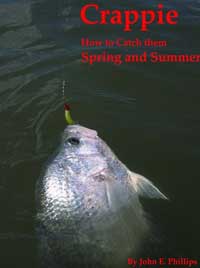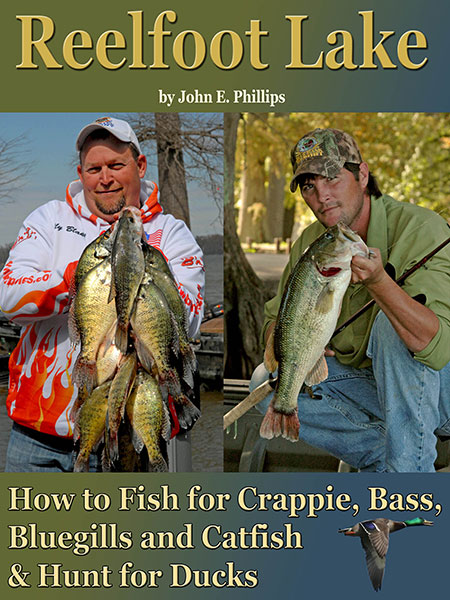Going Deep to Catch Crappie
Day 4: Concentrate Crappie Deep with Stake Beds and Sunken Treetops
Editor’s Note: Even with technological and informational advances in recent years, crappie anglers often have three misconceptions about crappie fishing, including: persons who fish for crappie are bound to the crappie-holding structure they can see; crappie anglers have to stop fishing when the crappie quit biting; and crappie fishermen who pinpoint productive locations must keep them secret from other anglers. But today’s crappie anglers are catching more and bigger fish than ever before, and here’s how they’re doing it.
  The fisherman who wants to take the guesswork out of finding and catching crappie can effectively do so if he understands crappie – what they like to do, and where they prefer to do what they do. The angler in search of crappie also has to be willing to devote time and energy to developing crappie habitat in an area that the crappie will use. A common mistake that many anglers make is that they try and build homes for crappie in regions where they already have homes. Sinking brush tops and making stake beds are effective tactics for drawing and maintaining crappie hot spots – if these structures are sunk in places where the crappie have no-other structure in which to hold. The fisherman who wants to take the guesswork out of finding and catching crappie can effectively do so if he understands crappie – what they like to do, and where they prefer to do what they do. The angler in search of crappie also has to be willing to devote time and energy to developing crappie habitat in an area that the crappie will use. A common mistake that many anglers make is that they try and build homes for crappie in regions where they already have homes. Sinking brush tops and making stake beds are effective tactics for drawing and maintaining crappie hot spots – if these structures are sunk in places where the crappie have no-other structure in which to hold.
Steve McCadams (www.stevemccadams.com) is a crappie guide who has to produce crappie for his clients all year long. To be consistent day after day, McCadams builds and sinks stake beds. “I sink my stake beds in open water away from the bank and not close to any other type of cover for two reasons,” McCadams says. “I believe, first of all, that I consistently can attract more crappie in an area where there’s no cover than in a place with plenty of cover. Crappie roam all over a lake. When they find cover like my stake beds, they’ll stop and hold on them. The other reason I like to put out-open water cover is that other anglers don’t find my stake beds and fish them to death. During certain times of the year, fishermen can keep the crappie pretty much caught-off of a good piece of cover, if they all know about it. For that reason, I fish my stake beds and try to keep their locations secret. If other sportsmen want to consistently catch crappie as I do, they can make their own stake beds, sink them in open water and catch crappie all year long.”
  My friend Tony Knight uses treetops instead of stake beds for making crappie homes. Although he sinks his tops in open water, he’s very particular about where and how he sinks his trees. “Knowing that crappie move up and down old creek channels and understanding that structure on the edges of these creek channels hold crappie, I sink my trees right on the edges of old river banks and creek banks,” Knight reports. “I like trees that will stand 6- to 10-feet off the bottom and have branches running from the bottoms to the tops of the trees. I want my sunken trees to be 3- to 4-feet under the surface where they can’t be seen. Those sunken trees become fish attractors that will stop and hold crappie moving along the old creek bank and also allow the fish to move vertically up and down in the water. My friend Tony Knight uses treetops instead of stake beds for making crappie homes. Although he sinks his tops in open water, he’s very particular about where and how he sinks his trees. “Knowing that crappie move up and down old creek channels and understanding that structure on the edges of these creek channels hold crappie, I sink my trees right on the edges of old river banks and creek banks,” Knight reports. “I like trees that will stand 6- to 10-feet off the bottom and have branches running from the bottoms to the tops of the trees. I want my sunken trees to be 3- to 4-feet under the surface where they can’t be seen. Those sunken trees become fish attractors that will stop and hold crappie moving along the old creek bank and also allow the fish to move vertically up and down in the water.
“In warm weather, the fish may be holding on top of or in the topmost branches of the tree. If the weather is cold, they may hold on the lower branches of the tree. But wherever the crappie wants to position itself in the water, it has structure to hold to, and I have a place I can catch the crappie at any time of the year. My trees are like a stop sign with an elevator. The crappie stop at the tree as they move up and down the old creek bank, and they can go up and down on the limbs of the tree to get to the comfort zone where they want to be. For me, sinking trees on submerged creek banks in open water provides a place to catch crappie any time of the year.”
  To learn more about crappie and how to fish for them from the masters of the sport, click here for “Crappie: How to Catch Them Spring and Summer,” a new eBook from Amazon’s Kindle by John E. Phillips. Also, you can learn more about crappie fishing from the Reelfoot Lake pros by purchasing the Kindle eBook, “Reelfoot Lake: How to Fish for Crappie, Bass, Bluegills and Catfish & Hunt for Ducks” by John E. Phillips. Or, go to http://www.amazon.com/kindle-ebooks, type in the names of the books, and download it to your Kindle, and/or download a Kindle app for your iPad, Smartphone or computer. To learn more about crappie and how to fish for them from the masters of the sport, click here for “Crappie: How to Catch Them Spring and Summer,” a new eBook from Amazon’s Kindle by John E. Phillips. Also, you can learn more about crappie fishing from the Reelfoot Lake pros by purchasing the Kindle eBook, “Reelfoot Lake: How to Fish for Crappie, Bass, Bluegills and Catfish & Hunt for Ducks” by John E. Phillips. Or, go to http://www.amazon.com/kindle-ebooks, type in the names of the books, and download it to your Kindle, and/or download a Kindle app for your iPad, Smartphone or computer.
About the Author
John Phillips, winner of the 2012 Homer Circle Fishing Award for outstanding fishing writer by the American Sportfishing Association (AMA) and the Professional Outdoor Media Association (POMA), the 2008 Crossbow Communicator of the year and the 2007 Legendary Communicator chosen for induction into the National Fresh Water Hall of Fame, is a freelance writer (over 6,000 magazine articles for about 100 magazines and several thousand newspaper columns published), magazine editor, photographer for print media as well as industry catalogues (over 25,000 photos published), lecturer, outdoor consultant, marketing consultant, book author and daily internet content provider with an overview of the outdoors. Click here for more information and a list of all the books available from John E. Phillips.
|
